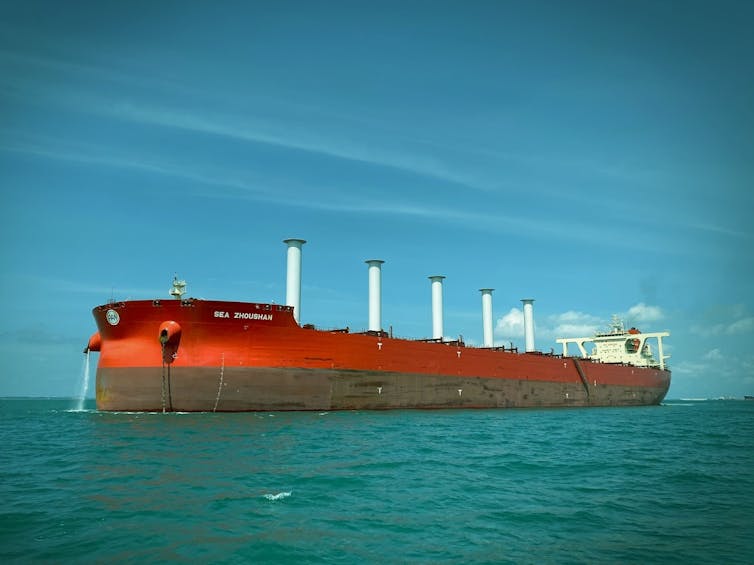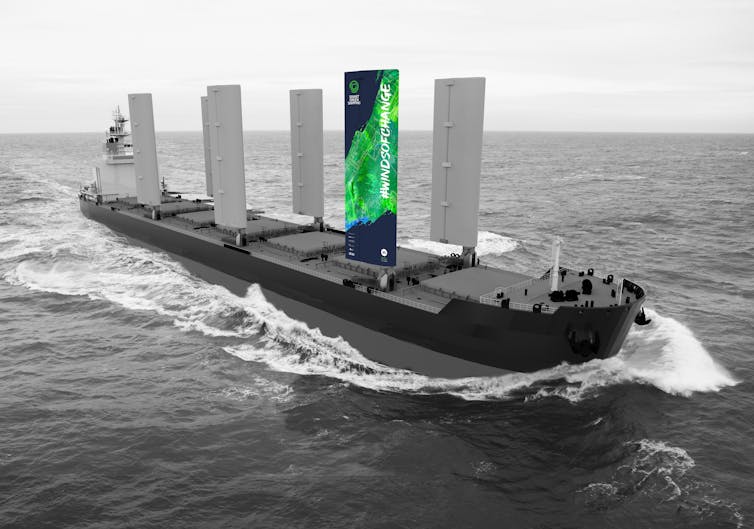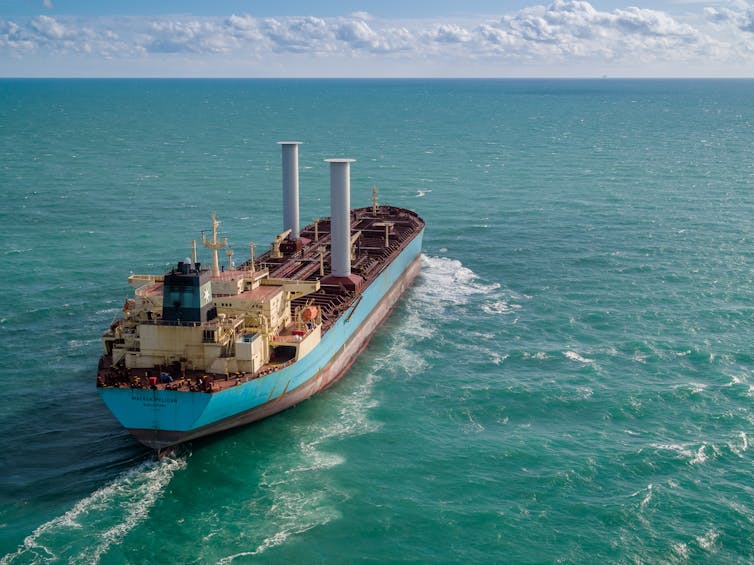
Norsepower, Author provided
James Mason, University of Manchester; Alice Larkin, University of Manchester, and Simon Bullock, University of Manchester
In the vast expanse of the world’s oceans, a transformation is underway.
The international shipping sector, made up of thousands of massive cargo ships laden with many of the goods we buy, emits carbon dioxide (CO₂) roughly equivalent to the entire country of Germany.
Our research emphasises the
need for immediate action. Reducing shipping emissions by 34% by 2030 is necessary to stay on course with the Paris Agreement’s 1.5°C goal. But with low-carbon fuel pipelines unlikely to be available at the necessary scale until at least the 2030s, how can the industry meet its short-term target?
Enter a new solution with ancient origins: sails. Not the billowing canvases of centuries past but high-tech systems capable of harnessing renewable wind energy to supplement the propulsion from a ship’s engine.
A number of advanced sail designs are gaining the attention of shipping firms. Two contenders include Flettner rotors, cylinders that spin to generate propulsion, and “wingsails”, which resemble aeroplane wings and are derived from designs used in yacht racing.

Smart Green Shipping, CC BY-ND
Wind propulsion allows ships to use less fuel and so emit less greenhouse gas. However, in our new paper, we found that the real opportunity to slash emissions from shipping this decade lies in combining sails with optimal routes plotted by satellite navigation systems.
An old idea with new technology
Optimised routing is a familiar concept to most of us. You’ll have used it by typing a destination into Google Maps and allowing its algorithms to calculate the quickest way for you to arrive at your destination.
The process is similar for ships. But instead of finding the quickest journey, the software models the ship’s performance in water to calculate routes and speeds that minimise fuel use.
With optimised routing and sails, ships can deviate from their standard course to seek out favourable winds. The ship may travel a longer distance but the extra power gained by the sails limits the ship’s fuel consumption and reduces the total emissions over the full journey. The software only suggests routes that guarantee the same arrival time, keeping the ship to its original schedule.
We used a computer model simulation of a cargo vessel with four sails, each taller than Brazil’s Christ the Redeemer statue at 35 meters high. By calculating the fuel consumption of this large bulk carrier ship on over 100,000 journeys spanning four years and covering 14 shipping routes worldwide, we found that sails can cut annual carbon emissions by around 10%.
The true promise of sails unfolds when optimal routing is used, increasing annual emission cuts to 17%.
Routes with ideal wind conditions have even greater potential. The most promising are typically those far from the equator, such as transatlantic and transpacific crossings, where strong winds can fill large sails. By taking advantage of wind patterns moving across the ocean on these routes, sails and optimised routing can cut annual emissions by over 30%.
Take the journey between the UK and the US as an example. A ship setting out on this voyage will typically experience strong headwinds which generate drag and push the ship backwards, meaning more fuel must be burned to maintain the same forward momentum. But by using sails and optimised routing software on this crossing, ships can avoid these headwinds and steer into more favourable winds.

Norsepower, CC BY-ND
On the return journey, the ship would typically experience strong winds from behind and the side, which would fill the sails and push the ship on. With optimised routing software the ship can find even stronger winds and fine-tune its direction for the sails to maximise propulsion.
Keeping the 1.5°C target afloat
The International Maritime Organization (the UN agency responsible for environmental regulation in shipping) has a target of cutting greenhouse gas emissions by 20%-30% by 2030. The Paris Agreement’s 1.5°C target requires even deeper cuts.
Our research shows that cuts to CO₂ of this magnitude are possible this decade using wind propulsion and optimised routing on promising routes. Achieving this will oblige the shipping industry to deploy existing technologies and practices and shift its focus from fuel alone, as zero-carbon fuels will take longer to develop.
As we sail further into the 21st century, our research delivers a clear message to the shipping industry: substantial carbon reductions are feasible this decade. Here is an old idea, one that integrates technology with tradition, that can steer international shipping towards its climate goals.

Don’t have time to read about climate change as much as you’d like?
Get a weekly roundup in your inbox instead. Every Wednesday, The Conversation’s environment editor writes Imagine, a short email that goes a little deeper into just one climate issue. Join the 20,000+ readers who’ve subscribed so far.![]()
James Mason, Visiting Academic in Decarbonisation, University of Manchester; Alice Larkin, Professor of Climate Science and Energy Policy, University of Manchester, and Simon Bullock, Research Associate, Shipping and Climate Change, University of Manchester
This article is republished from The Conversation under a Creative Commons license. Read the original article.







